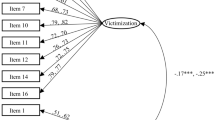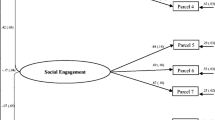Abstract
The Multidimensional Peer Victimization Scale (MPVS; Mynard and Joseph, British Journal of Educational Psychology, 67, 51-54 2000) is a 16-item self-report scale that captures peer victimization across four dimensions: physical victimization, verbal victimization, social manipulation, and attacks on property. Performance of the scale has not been evaluated among older adolescents. We examined the factor structure, internal consistency reliability, and performance of the scale in two separate epidemiological U.S. samples representing different age groups: 9–14 year olds (N = 610) and 15–17 year olds (N = 524). The four-factor structure of the scale was affirmed in both samples, however; there was not metric invariance by gender in the younger age group. The scale and its subscales were found to have good internal consistency. Expected relationships between the MPVS and measures of irritability, anxiety, and depression were affirmed. Results support continued use of the MPVS among child and adolescent samples.


Similar content being viewed by others
References
Angold, A., Costello, E. J., Messer, S. C., Pickles, A., Winder, F., & Silver, D. (1995). Development of a short questionnaire for use in epidemiological studies of depression in children and adolescents. International Journal of Methods in Psychiatric Research, 5, 237–249.
Arseneault, L., Bowes, L., & Shakoor, S. (2010). Bullying victimization in youths and mental health problems: ‘Much ado about nothing’? Psychological Medicine, 40, 717–729. https://doi.org/10.1017/S0033291709991383.
Balogun, S. K., & Olapegba, P. O. (2007). Cultural validation of the multidimensional peer victimization scale in Nigerian children. Journal of Cross-Cultural Psychology, 38, 573–580. https://doi.org/10.1177/0022022107305239.
Betts, L. R., Houston, J. E., & Steer, O. L. (2015). Development of the multidimensional peer victimization scale–revised (MPVS-R) and the multidimensional peer bullying scale (MPVS-RB). The Journal of Genetic Psychology, 176, 93–109. https://doi.org/10.1080/00221325.2015.1007915.
Birmaher, B., Khetarpal, S., Brent, D., Cully, M., Balach, L., Kaufman, J., & Neer, S. M. (1997). The screen for child anxiety related emotional disorders (SCARED): Scale construction and psychometric characteristics. Journal of the American Academy of Child and Adolescent Psychiatry, 36, 545–553. https://doi.org/10.1097/00004583-199704000-00018.
Birmaher, B., Brent, D. A., Chiappetta, L., Bridge, J., Monga, S., & Baugher, M. (1999). Psychometric properties of the screen for child anxiety related emotional disorders (SCARED): A replication study. Journal of the American Academy of Child and Adolescent Psychiatry, 38, 1230–1236. https://doi.org/10.1097/00004583-199910000-00011.
Björkqvist, K., Lagerspetz, K. M., & Kaukiainen, A. (1992). Do girls manipulate and boys fight? Developmental trends in regard to direct and indirect aggression. Aggressive Behavior, 18, 117–127. https://doi.org/10.1002/1098-2337(1992)18:2<117::AID-AB2480180205>3.0.CO;2-3.
Boivin, M., Petitclerc, A., Feng, B., & Barker, E. D. (2010). The developmental trajectories of peer victimization in middle to late childhood and the changing nature of their behavioral correlates. Merrill-Palmer Quarterly, 56, 231–260. https://doi.org/10.1353/mpq.0.0050.
Bollen, K. A. (1989). Structural equations with latent variables. New York, NY: Wiley. https://doi.org/10.1002/9781118619179.
Bowen, N. K., & Masa, R. D. (2015). Conducting measurement invariance tests with ordinal data: A guide for social work researchers. Journal of the Society for Social Work and Research, 6(2), 229–249. https://doi.org/10.1086/681607.
Browne, M. W., & Cudeck, R. (1993). Alternative ways of assessing model fit. Sage Focus Editions, 154, 136–136.
Carney, D. M., Moroney, E., Machlin, L., Hahn, S., Savage, J. E., Lee, M., … & Hettema, J. M. (2016). The twin study of negative valence emotional constructs. Twin Research and Human Genetics, 19, 456–464. https://doi.org/10.1017/thg.2016.59.
Casper, D. M., & Card, N. A. (2017). Overt and relational victimization: A meta-analytic review of their overlap and associations with social–psychological adjustment. Child Development, 88(2), 466–483.
Cecilione, J., Rappaport, L., Hahn, S., Anderson, A., Hazlett, L., Burchett, J., … Roberson-Nay, R. (2018). Genetic and environmental contributions of negative valence systems to internalizing pathways. Twin Research and Human Genetics, 21(1), 12–23. https://doi.org/10.1017/thg.2017.72.
Cheung, G. W., & Rensvold, R. B. (2002). Evaluating goodness-of-fit indexes for testing measurement invariance. Structural Equation Modeling, 9, 233–255. https://doi.org/10.1207/S15328007SEM0902_5.
Cook, C. R., Williams, K. R., Guerra, N. G., Kim, T. E., & Sadek, S. (2010). Predictors of bullying and victimization in childhood and adolescence: A meta-analytic investigation. School Psychology Quarterly, 35, 65–83. https://doi.org/10.1037/a0020149.
Crothers, L. M., & Levinson, E. M. (2004). Assessment of bullying: A review of methods. Journal of Counseling and Development, 82, 496–503. https://doi.org/10.1002/j.1556-6678.2004.tb00338.x.
Demaray, M. K., Malecki, C. K., Secord, S. M., & Lyell, K. M. (2013). Agreement among students’, teachers’, and parents’ perceptions of victimization by bullying. Children and Youth Services Review, 35, 2091–2100. https://doi.org/10.1016/j.childyouth.2013.10.018.
Eysenck, H. J. (1975). Manual of the Eysenck personality questionnaire. San Diego, CA: Digits.
Eysenck, S. B., Eysenck, H. J., & Barrett, P. (1985). A revised version of the psychoticism scale. Personality and Individual Differences, 6, 21–29. https://doi.org/10.1016/0191-8869(85)90026-1.
Fitzpatrick, S., & Bussey, K. (2011). The development of the social bullying involvement scales. Aggressive Behavior, 37, 177–192. https://doi.org/10.1002/ab.20379.
Goldbaum, S., Craig, W. M., Pepler, D., & Connolly, J. (2003). Developmental trajectories of victimization: Identifying risk and protective factors. Journal of Applied School Psychology, 19, 139–156. https://doi.org/10.1300/J008v19n02_09.
Graham, S., & Juvonen, J. (1998). Self-blame and peer victimization in middle school: An attributional analysis. Developmental Psychology, 34, 587–599. https://doi.org/10.1037/0012-1649.34.3.587.
Gromann, P. M., Goossens, F. A., Olthof, T., Pronk, J., & Krabbendam, L. (2013). Self- perception but not peer reputation of bullying victimization is associated with non- clinical psychotic experiences in adolescents. Psychological Medicine, 43, 781–787. https://doi.org/10.1017/S003329171200178X.
Harris, P. A., Taylor, R., Thielke, R., Payne, J., Gonzalez, N., & Conde, J. G. (2009). Research electronic data capture (REDCap)—A metadata-driven methodology and workflow process for providing translational research informatics support. Journal of Biomedical Informatics, 42, 377–381. https://doi.org/10.1016/j.jbi.2008.08.010.
Hill, J. P., & Lynch, M. E. (1983). The intensification of gender-related role expectations during early adolescence. In Girls at puberty (pp. 201–228). Boston: Springer.
Hu, L. T., & Bentler, P. M. (1999). Cutoff criteria for fit indexes in covariance structure analysis: Conventional criteria versus new alternatives. Structural Equation Modeling: A Multidisciplinary Journal, 6, 1–55. https://doi.org/10.1080/10705519909540118.
Hudson, W. (1990). A short-form scale to measure peer relations dysfunction. Journal of Social. Service Research, 13, 57–69. https://doi.org/10.1300/J079v13n04_04.
Hudson, W. W., Nurius, P. S., Daley, J. G., & Newsome, R. D. (1993). Index of peer relations (IPR). Tallahassee, FL: Walmyr Publishing Company.
Jensen-Campbell, L. A., Adams, R., Perry, D. G., Workman, K. A., Furdella, J. Q., & Egan, S. K. (2002). Agreeableness, extraversion, and peer relations in early adolescence: Winning friends and deflecting aggression. Journal of Research in Personality, 36, 224–251. https://doi.org/10.1006/jrpe.2002.2348.
Kuo, E., Stoep Vander, A., & Steward, D. G. (2005). Using the short mood and feelings.Questionnaire to detect depression in detained adolescents. Assessment, 12, 374–383. https://doi.org/10.1177/1073191105279984.
Ladd, G. W., Ettekal, I., & Kochenderfer-Ladd, B. (2017). Peer victimization trajectories from kindergarten through high school: Differential pathways for children’s school engagement and achievement? Journal of Educational Psychology. Advance online publication., 109, 826–841. https://doi.org/10.1037/edu0000177.
Lamarche, V., Brendgen, M., Boivin, M., Vitaro, F., Perusse, D., & Dionne, G. (2006). Do friendships and sibling relationships provide protection against peer victimization in a similar way? Social Development, 15(3), 373–393. https://doi.org/10.1111/j.1467-9507.2006.00347.x.
Lilley, E. C., & Silberg, J. L. (2013). The mid-Atlantic twin registry, revisited. Twin Research and Human Genetics, 16, 424–428. https://doi.org/10.1017/thg.2012.125.
Marsh, H. W. (1994). Confirmatory factor analysis models of factorial invariance: A multifaceted approach. Structural Equation Modeling, 1(1), 5–34. https://doi.org/10.1080/10705519409539960.
Muthén, L. K., & Muthén, B. O. (1998-2017). Mplus User’s Guide (Eighth ed.). Los Angeles, CA: Muthén & Muthén.
Mynard, H., & Joseph, S. (1997). Bully/victim problems and their association with Eysenck's personality dimensions in 8 to 13 year-olds. British Journal of Educational Psychology, 67, 51–54. https://doi.org/10.1111/j.2044-8279.1997.tb01226.x.
Mynard, H., & Joseph, S. (2000). Development of the multidimensional peer-victimization scale. Aggressive Behavior, 26, 169–178. https://doi.org/10.1002/(SICI)1098-2337(2000)26:2<169::AID-AB3>3.0.CO;2-A.
Plomin, R. (1976). Extraversion: Sociability and impulsivity? Journal of Personality Assessment, 40(1), 24–30. https://doi.org/10.1207/s15327752jpa4001_6.
Pulkkinen, L., Vaalamo, I., Hietala, R., Kaprio, J., & Rose, R. J. (2003). Peer reports of adaptive behavior in twins and singletons: Is twinship a risk or an advantage? Twin Research and Human Genetics, 6(2), 106–118. https://doi.org/10.1375/136905203321536236.
Rhew, I. C., Simpson, K., Tracy, M., Lymp, J., McCauley, E., Tsuang, D., & Vander Stoep, A. (2010) Criterion validity of the Short Mood and Feelings Questionnaire and one-and two-item depression screens in young adolescents. Child and Adolescent Psychiatry and Mental Health, 4, 8. https://doi.org/10.1186/1753-2000-4-8
Riordan, C. M., & Vandenberg, R. J. (1994). A central question in cross-cultural research: Do employees of different cultures interpret work-related measures in an equivalent manner? Journal of Management, 20, 643–671. https://doi.org/10.1177/1094428103251542.
Rivers, I., & Smith, P. K. (1994). Types of bullying behaviour and their correlates. Aggressive. Behavior, 20, 359–368. https://doi.org/10.1002/1098-2337(1994)20:5<359::AID-AB2480200503>3.0.CO;2-J.
SAS Institute Inc. (2013). SAS 9.4 Cary, NC: SAS Institute Inc., Cary, NC, USA.
Schumacker, R. E., & Lomax, R. G. (1996). A beginner’s guide to structural equation modeling. Mahwah, NJ: Erlbaum. https://doi.org/10.1080/10705519609540025.
Shetgiri, R., Lin, H., & Flores, G. (2013). Trends in risk and protective factors for child bullying perpetration in the United States. Child Psychiatry and Human Development, 44, 89–104. https://doi.org/10.1007/s10578-012-0312-3.
Silberg, J. L., Copeland, W., Linker, J., Moore, A. A., Roberson-Nay, R., & York, T. P. (2016). Psychiatric outcomes of bullying victimization: A study of discordant monozygotic twins. Psychological Medicine, 46, 1875–1883. https://doi.org/10.1017/S0033291716000362.
Stringaris, A., Goodman, R., Ferdinando, S., Razdan, V., Muhrer, E., Leibenluft, E., & Brotman, M. A. (2012). The affective reactivity index: A concise irritability scale for clinical and research settings. Journal of Child Psychology and Psychiatry, 53, 1109–1117. https://doi.org/10.1111/j.1469-7610.2012.02561.
Sumter, S. R., Baumgartner, S. E., Valkenburg, P. M., & Peter, J. (2012). Developmental trajectories of peer victimization: Off-line and online experiences during adolescence. Journal of Adolescent Health, 50, 607–613. https://doi.org/10.1016/j.jadohealth.2011.10.251.
Tackett, J. L., Kushner, S. C., Herzhoff, K., Smack, A. J., & Reardon, K. W. (2014). Viewing relational aggression through multiple lenses: Temperament, personality, and personality pathology. Development and Psychopathology, 26(3), 863–877. https://doi.org/10.1017/S0954579414000443.
Tavakol, M., & Dennick, R. (2011). Making sense of Cronbach’s alpha. International Journal of. Medical Education, 2, 53–55. https://doi.org/10.5116/ijme.4dfb.8dfd.
Thapar, A., & McGuffin, P. (1998). Validity of the shortened mood and feelings questionnaire in a community sample of children and adolescents: A preliminary research note. Psychiatry Research, 81, 259–268. https://doi.org/10.1016/S0165-1781(98)00073-0.
Wang, J., Iannotti, R. J., & Nansel, T. R. (2009). School bullying among adolescents in the. United States: Physical, verbal, relational, and cyber. Journal of Adolescent Health, 45, 368–375. https://doi.org/10.1016/j.jadohealth.2009.03.021
Acknowledgements
This project was supported by National Institute of Mental Health grants R01MH098055 (J.M.H.), R01MH101518 (R.R.-N.), T32MH020030 (M.L.E.), as well as UL1TR000058 from the National Center for Research Resources (for REDCap). We are grateful for the contributions of the twins and their families who participated in the studies providing data for this article.
Funding
This study was funded by National Institute of Mental Health grants R01MH098055 and R01MH101518, T32MH020030, as well as UL1TR000058 from the National Center for Research Resources (for REDCap).
Author information
Authors and Affiliations
Corresponding author
Ethics declarations
Conflict of Interest
Meridith L. Eastman, Ashlee A. Moore, Jennifer Cecilione, John M. Hettema, and Roxann Roberson-Nay declare that they have no conflict of interest.
Ethical Approval
This article does not contain any studies with animals performed by any of the authors.
Informed Consent
Informed consent was obtained from all individual participants included in the study.
Experiment Participants
All procedures performed in studies involving human participants were in accordance with the ethical standards of the institutional and/or national research committee and with the 1964 Helsinki declaration and its later amendments or comparable ethical standards.
Appendix
Appendix
Rights and permissions
About this article
Cite this article
Eastman, M.L., Moore, A.A., Cecilione, J. et al. Confirmatory Factor Structure and Psychometric Properties of the Multidimensional Peer Victimization Scale. J Psychopathol Behav Assess 40, 725–735 (2018). https://doi.org/10.1007/s10862-018-9678-2
Published:
Issue Date:
DOI: https://doi.org/10.1007/s10862-018-9678-2




